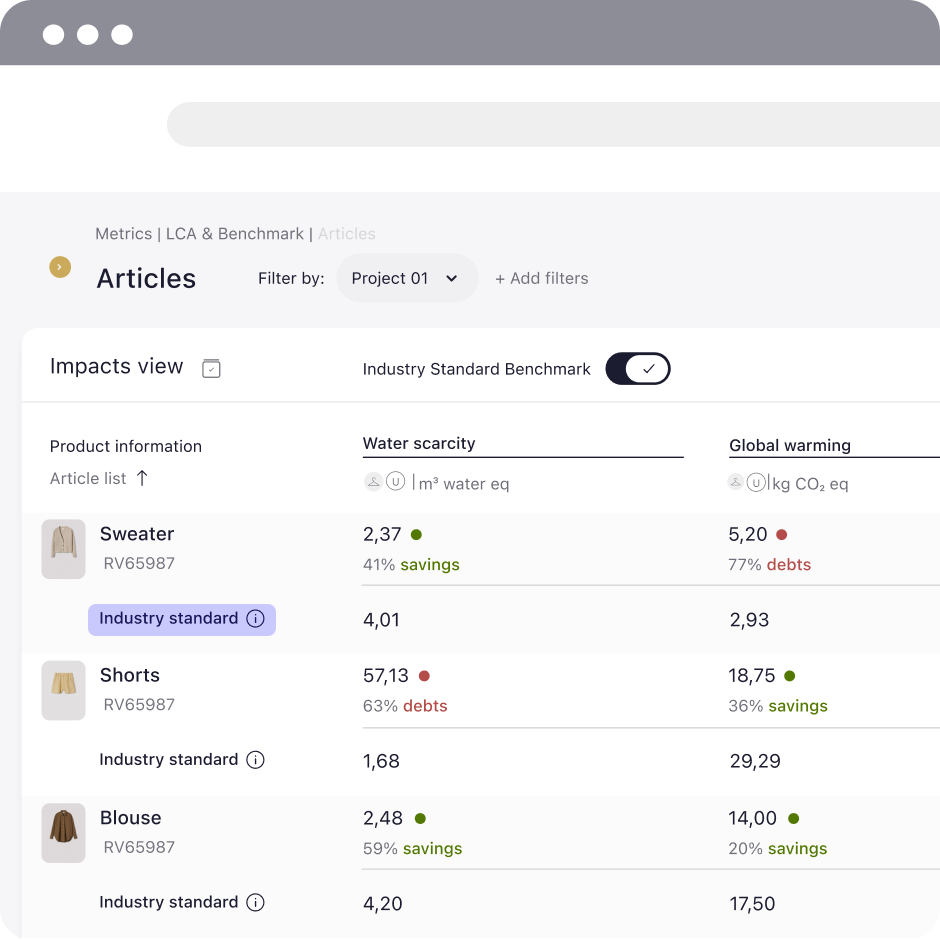Based on the LCA methodology, this tool is able to calculate environmental savings when a product’s impact is below the fashion industry standard, and environmental debts when it exceeds it. Do you want to know if your products perform better or worse than the industry standard in relation to the four environmental impact indicators? Benchmark’s tool will be your best ally.
👉🏻 How do I access to this feature? Go to the Metrics → Life Cycle Assessment (LCA) Then, activate the Industry Standard Benchmark toggle switch. And discover the Relative and the Absolute Benchmark results of your LCA Data.
What information can I visualize in this tool?

The information is classified into:
- Impact: Impact of the LCA article.
- Benchmark: Result in percentage of the comparison between the impact of your article and the impact of the opposite scenario.
- Industry standard: Absolute impact of the opposite scenario.
What results can I get from the comparison?
The results of this assessment represent the percentage or amount of:
- Environmental savings: When the environmental impact of a product is below the industry benchmark, meaning that the difference in impacts between the benchmark and the corresponding LCA indicator is positive. It is therefore considered that impacts were avoided from production. The information will be displayed in green.
- Environmental debts: When the environmental impact of a product is above the industry benchmark, meaning that the difference in impacts between the benchmark and the corresponding LCA indicator is negative. It is therefore considered that impacts are higher than the standard. The information will be displayed in red.

What is the Industry standard based on?
To find out more information about the industry standard, click on the information point ℹ️ next to the row title Industry standard. It will indicate the benchmark scenario.
The Benchmark represent conventional scenarios following the global market and their impacts are calculated following the same methodology applied to assess the environmental impacts of the client’s collection. The calculation methodology developed by BCome is based on the construction of conventional scenarios based on the modification of:
- The composition of the main materials that make up each product.
- The wet processes (coloration, print, and treatments).
- The type of transport used between raw material extraction (Tier 4) and manufacturing (Tier 1), and from manufacturing (Tier 1) to the warehouse.
- The origin of the raw materials, material processes, wet processes and manufacturing (Tier 4, Tier 3, Tier 2, and Tier 1).
- The packaging (tertiary, secondary and primary).

In each scenario, the same product functionality and weights are always maintained. To ensure consistent benchmarking, BCome has created a series of tables setting out the most common conventional reference scenarios for each raw material, material, and transport category. Check the latest version of the methodology to access these tables.